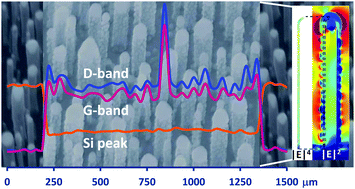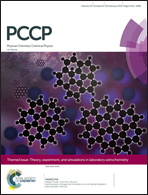Origin of enhancement in Raman scattering from Ag-dressed carbon-nanotube antennas: experiment and modelling†
Abstract
The D- and G-band Raman signals from random arrays of vertically aligned, multi-walled carbon nanotubes are significantly enhanced (up to ∼14×) while the signal from the underlying Si substrate is simultaneously attenuated (up to ∼6×) when the nanotubes are dressed, either capped or coated, with Ag. These Ag-induced counter-changes originate with the difference in geometry of the nanotubes and planar Si substrate and contrast in the Ag depositions on the substrate (essentially thin film) and the nanotube (nano-particulate). The surface integral equation technique is used to perform detailed modelling of the electromagnetic response of the system in a computationally efficient manner. Within the modelling the overall antenna response of the Ag-dressed nanotubes is shown to underpin the main contribution to enhancement of the nanotube Raman signal with hot-spots between the Ag nanoparticles making a subsidiary contribution on account of their relatively weak penetration into the nanotube walls. Although additional hot-spot activity likely accounts for a shortfall in modelling relative to experiment it is nonetheless the case that the significant antenna-driven enhancement stands in marked contrast to the hot-spot dominated enhancement of the Raman spectra from molecules adsorbed on the same Ag-dressed structures. The Ag-dressing procedure for amplifying the nanotube Raman output not only allows for ready characterisation of individual nanotubes, but also evidences a small peak at ∼1150 cm−1 (not visible for the bare, undressed nanotube) which is suggested to be due to the presence of trans-polyacetylene in the structures.



 Please wait while we load your content...
Please wait while we load your content...